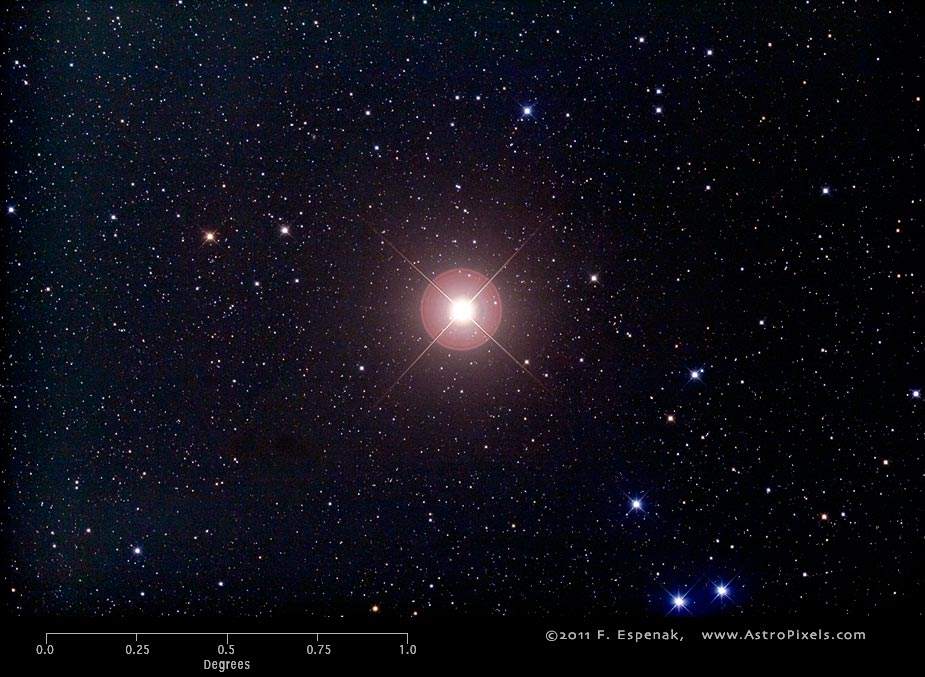Aldebaran
Aldebaran or Alpha Tauri (Alp Tau) is the brightest naked eye star in the constellation Taurus. With an apparent magnitude of 0.87, Aldebaran is the 14th brightest star in the entire sky (see: 50 Brightest Stars ). Its absolute magnitude is -0.63 and its distance is 65 light years.The Equinox J2000 equatorial coordinates are RA = 04h 35m 55.2s, Dec = +16° 30' 33".
Aldebaran has a spectral type of K5III, a surface temperature of 4010° Kelvin and a luminosity 425 times the Sun. It has a mass of 1.7 solar masses and a diameter 44.2 times the Sun.
The image above shows the uncropped view of Aldebaran (North is up) through the Takahashi E-180 Astrograph.
Aldebaran is an orange giant star that has moved off the main sequence line of the Hertzsprung-Russell diagram. It has exhausted the hydrogen fuel in its core and hydrogen fusion has ceased there. Although not yet hot enough for fusing helium, the core temperature of the star has greatly increased due to gravitational pressure and the star has expanded to a diameter of 44.2 times the diameter of the Sun, approximately 61 million kilometres. The Hipparcos satellite has measured its distance as 65.1 light-years (20.0 parsecs) away, and it shines with 150 times the Sun's luminosity.Aldebaran is a slightly variable star, of the slow irregular variable type LB. It varies by about 0.2 in apparent magnitude.
Aldebaran is one of the easiest stars to find in the night sky, partly due to its brightness and partly due to its spatial relation to one of the more noticeable asterisms in the sky. If one follows the three stars of Orion's belt from left to right (in the Northern Hemisphere) or right to left (in the Southern), the first bright star found by continuing that line is Aldebaran.
Aldebaran has the appearance of being the brightest member of the more scattered Hyades open star cluster that makes up the bull's head shaped asterism in Taurus. However, Aldebaran is merely located by chance in the line of sight between Earth and the Hyades; the star cluster is actually more than twice as far away, at about 150 light years.
The name Aldebaran is Arabic and translates literally as "the follower", presumably because this bright star appears to follow the Pleiades, or "Seven Sisters" star cluster in the night sky.
The description above is based on the Aldebaran entry in Wikipedia.For more information about Aldebaran, see Stars (Jim Kaler).
Technical Details
- Object: Aldebaran
- Other Names: Alpha Tauri, HR1457, HD29139, HIP21421
- Object Type: bright star
- Object Data: Apparent Magnitude = 0.87, Absolute Magnitude = -0.63, distance = 65 light years
- Object Position (Equinox J2000): RA = 04h 35m 55.2s, Dec = +16° 30' 33", Constellation = Taurus
- Date/Time: 2011 Oct 22 at 06:54:07 UTC
- Location: Bifrost Astronomical Observatory, Portal, AZ
- Mount: Astro-Physics 1200GTO
- Telescope: Takahashi Epsilon 180 Hyperbolic Astrograph
- Camera: Canon EOS 550D (Rebel T2i) (modified with a Baader UV/IR filter)
- Field of View: 1.70° x 2.56° at 1.7 arc-sec/pixel (web version: 10.0 arc-sec/pixel)
- Exposure: 2 x 300s, f/2.8, ISO 800
- File Name: Aldebaran-01w.jpg
- Processing (Adobe Camera Raw): Graduated Filter, Vignetting Correction, Noise Reduction, White Balance, Curves
- Processing (Photoshop CS5): Average Images, Curves, Noise Reduction
- Original Image Size: 3454 × 5179 pixels (17.9 MP); 11.5" x 17.3" @ 300 dpi
- Rights: Copyright 2011 by Fred Espenak. All Rights Reserved. See: Image Licensing.
